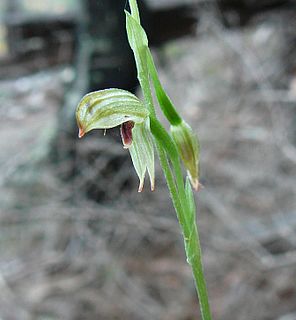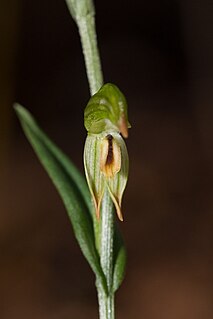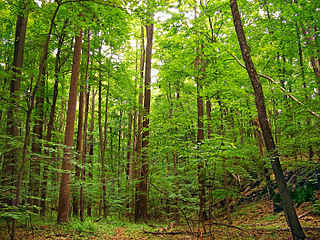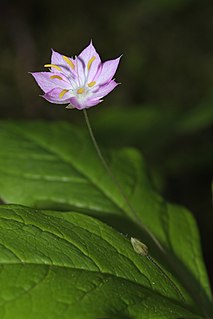
Pterostylis tunstallii, commonly known as Tunstall's greenhood or granite greenhood is a plant in the orchid family Orchidaceae and is endemic to south-eastern Australia. Flowering plants have up to ten transparent green flowers which have a dark brown, insect-like labellum with a blackish "head". Non-flowering plants have a rosette of leaves on a short stalk but flowering plants lack the rosette, instead having five to eight stem leaves.

Pterostylis jonesii, commonly known as the montane leafy greenhood, is a plant in the orchid family Orchidaceae and is endemic to a small area of south-eastern Australia. Individual plants have either a rosette of three to six leaves or a flowering spike with up to eleven flowers and five to seven stem leaves. The flowers are translucent green with faint darker green lines and have a brownish-yellow labellum with a dark stripe.
Pterostylis commutata, commonly known as the midland rustyhood is a plant in the orchid family Orchidaceae and is endemic to Tasmania. It has a rosette of leaves near its base and up to five translucent white and green flowers with a hairy, insect-like labellum. It is only found in a small area near Tunbridge and Ross.

Pterostylis daintreana, commonly known as Daintree's greenhood, is a species of orchid endemic to eastern Australia. The non-flowering plants have a rosette of leaves on short stalks but flowering plants have up to ten flowers with rosettes on the side of the flowering spike. The flowers are translucent white with dark green lines and long, downcurved lateral sepals.
Pterostylis frenchii, commonly known as the tuart rufous greenhood, or tuart rustyhood is a plant in the orchid family Orchidaceae and is endemic to the south-west of Western Australia. Both flowering and non-flowering plants have a relatively large rosette of leaves. Flowering plants also have up to twelve white and green or white and brown flowers which lean forward and have a small, fleshy, insect-like labellum.
Pterostylis ferruginea, commonly known as the Bangham rustyhood, is a plant in the orchid family Orchidaceae and is endemic to the border area between South Australia and Victoria. It has a rosette of leaves and when flowering, up to ten upright, dark green and translucent white flowers which have an insect-like labellum.
Pterostylis gibbosa, commonly known as the Illawarra rustyhood, or Illawarra greenhood, is a plant in the orchid family Orchidaceae and is endemic to New South Wales. It has a rosette of leaves at its base and up to nine bright green flowers with translucent "windows", relatively wide lateral sepals with short-pointed tips and a dark, fleshy, insect-like labellum.
Pterostylis insectifera, commonly known as the insect-lipped rufous greenhood, or leaden rustyhood is a plant in the orchid family Orchidaceae and is endemic to the south-west of Western Australia. Both flowering and non-flowering plants have a relatively large rosette of leaves. Flowering plants have a similar rosette and up to eight or more flowers which have long, stiffly-held lateral sepals and a protruding, insect-like labellum.
Pterostylis leptochila, commonly known as the Ravensthorpe rufous greenhood or narrow-lipped rustyhood is a plant in the orchid family Orchidaceae and is endemic to the south-west of Western Australia. Both flowering and non-flowering plants have a relatively large rosette of leaves. Flowering plants also have up to five large translucent white flowers with olive green and brown lines and markings and a narrow, insect-like labellum.
Pterostylis macrocalymma, commonly known as the large-hooded rufous greenhood or Murchison rustyhood is a plant in the orchid family Orchidaceae and is endemic to the south-west of Western Australia. Both flowering and non-flowering plants have a relatively large rosette of leaves. Flowering plants also have up to ten or more white flowers with bold green or pale brown lines and a broad spoon-shaped, insect-like labellum.
Pterostylis macrosceles, commonly known as the slender rufous greenhood is a plant in the orchid family Orchidaceae and is endemic to the south-west of Western Australia. Both flowering and non-flowering plants have a relatively large rosette of leaves. Flowering plants also have between four and eight white flowers with green brown lines and small, insect-like labellum. It is distinguished from other Western Australian greenhoods by the unusually long thread-like tips on its sepals.

Pterostylis mirabilis, commonly known as the nodding rufous-hood, is a plant in the orchid family Orchidaceae and is endemic to South Australia. It has a rosette of leaves at its base and up to ten greenish-white flowers with a narrow hood, down-turned lateral sepals and a thin-textured, insect-like labellum.
Pterostylis picta, commonly known as the painted rufous greenhood or painted rustyhood is a plant in the orchid family Orchidaceae and is endemic to the south-west of Western Australia. Both flowering and non-flowering plants have a relatively large rosette of leaves. Flowering plants also have up to seven large translucent white flowers with green and brown stripes and markings and a fleshy, insect-like labellum.

Pterostylis prasina, commonly known as the mallee leafy greenhood, is a plant in the orchid family Orchidaceae and is endemic to southern continental Australia. Non-flowering have a rosette of leaves on a short stalk, but flowering plants lack the rosette and have up to eight pale green and translucent green flowers with darker green lines. The flowers have a pale green labellum with a darker central line. It is a common and widespread greenhood in parts of Victoria and South Australia.
Pterostylis psammophila, commonly known as the two-bristle greenhood, is a plant in the orchid family Orchidaceae and is endemic to South Australia. Both flowering and non-flowering plants have a rosette of leaves and flowering plants have translucent green and white flowers with an insect-like labellum, but the flowers are only open for a few days.
Pterostylis roensis, commonly known as the painted rufous greenhood or dark rustyhood is a plant in the orchid family Orchidaceae and is endemic to the south-west of Western Australia. Both flowering and non-flowering plants have a relatively large rosette of leaves. Flowering plants also have up to six green or brown to blackish flowers with translucent white panels and a dark brown, fleshy, insect-like labellum.
Pterostylis saxicola, commonly known as the Sydney plains rustyhood, or Sydney plains greenhood, is a plant in the orchid family Orchidaceae and is endemic to New South Wales. It has a rosette of leaves at its base and up to ten reddish-brown flowers with translucent "windows", relatively wide lateral sepals with short-pointed tips and a dark brown, fleshy, insect-like labellum.
Pterostylis stenosepala, commonly known as the narrow-sepalled leafy greenhood, is a plant in the orchid family Orchidaceae and is endemic to New South Wales. Flowering plants have up to six shiny, translucent green flowers with darker green stripes. The flowers have an insect-like labellum which is green with a dark green mound on its upper end. Non-flowering plants have a rosette of leaves on a stalk, but flowering plants lack the rosette, instead having between four and eight stem leaves.
Pterostylis xerophila, commonly known as the desert rustyhood, is a plant in the orchid family Orchidaceae and is endemic to South Australia. Both flowering and non-flowering plants have a relatively large rosette of leaves. Flowering plants also have up to eight translucent white, green and reddish-brown flowers with an insect-like labellum.
Pterostylis exserta, commonly known as the exserted rufous greenhood, is a species of orchid endemic to the south-west of Western Australia. Both flowering and non-flowering plants have a large rosette of leaves flat on the ground and flowering plants have up to seven pale, transparent green and white flowers with brownish lines.

















